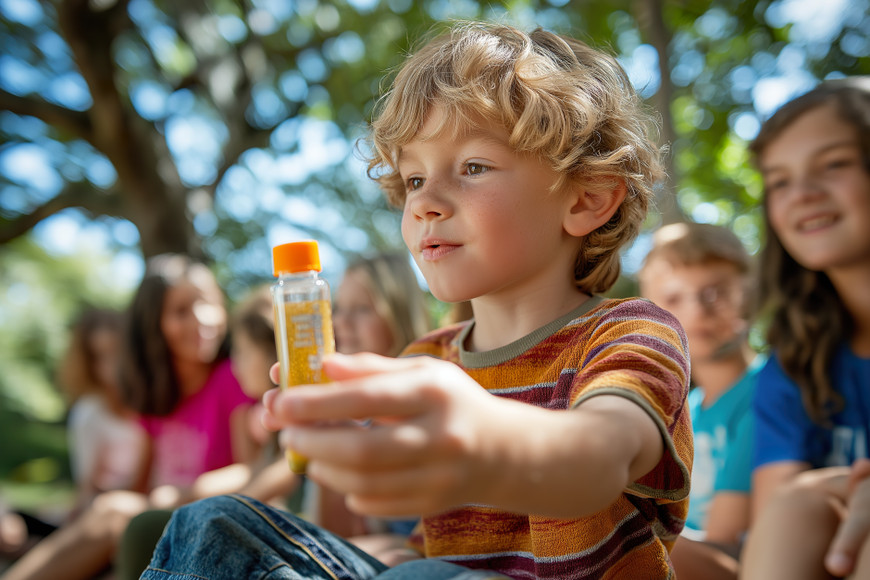May is Food Allergy Awareness Month, a time that holds deep personal significance for me as both a business owner and a mom of two boys with severe food allergies. When my second son was diagnosed with multiple food allergies as a toddler, my world changed overnight. Suddenly, everyday situations—birthday parties, school lunches, playdates—became potential hazards requiring careful navigation and constant vigilance. This intensely personal experience directly inspired our line of safety labels for children with allergies designed to protect children with medical needs.
Understanding the Scope of Food Allergies Today
Food allergies affect approximately 8% of children in the United States—that's about 1 in 13 children or roughly two in every classroom. As a mom who's lived this reality, these aren't just statistics to me—they represent real children and families navigating complex challenges daily. More concerning is that the prevalence of food allergies in children increased by 50% between 1997 and 2011, and this trend continues today.
The eight most common allergens—milk, eggs, peanuts, tree nuts, fish, shellfish, soy, and wheat—account for 90% of all food allergic reactions. However, children can be allergic to virtually any food, making clear communication about specific allergies crucial. My own sons' allergies include several less common triggers, which taught me the importance of clear, specific allergy communication.
The Communication Gap in Childcare Settings
Children spend significant time under the care of people other than their parents—teachers, daycare providers, camp counselors, babysitters, and relatives. Each transition between caregivers creates an opportunity for crucial medical information to be missed or forgotten—something I experienced firsthand when a substitute teacher was unaware of my son's allergies during a class party.
This communication gap is what our Allergy Alert Labels are designed to bridge. By providing clear, consistent visual reminders that stay with the child's belongings, these labels ensure that critical health information travels wherever your child goes—a solution born directly from my own fears and challenges as an allergy mom.
Beyond Allergies: Comprehensive Safety Labeling
While food allergies are a primary concern for many families like mine, our safety label collection addresses multiple aspects of child safety:
Medical Alert Labels
For children with conditions like diabetes, asthma, epilepsy, or heart conditions, our Medical Alert Labels provide essential information to caregivers. These waterproof medical labels for children can include:
- Specific medical conditions and their symptoms
- Medication requirements and dosage information
- Warning signs caregivers should watch for
- Action steps for emergencies and when to call parents
The waterproof, dishwasher-safe quality means these labels remain legible even when applied to water bottles, lunch containers, or medical equipment that requires frequent cleaning—a feature I insisted on after seeing how quickly standard medical alert stickers deteriorated on my son's lunch containers.
Emergency Contact Labels
In situations where immediate parent contact is necessary, our Emergency Contact Labels provide caregivers with the information they need. These emergency information labels for children can be applied to:
- Backpacks and lunch boxes for school and daycare
- Car seats and travel gear for transportation
- Medication cases and EpiPen carriers
- Inside jackets and coat labels for field trips and outings
Real-World Applications: Where Safety Labels Make a Difference
School and Daycare Settings
In busy classrooms and daycare centers, teachers and staff are responsible for many children with diverse needs. Our allergy alert labels for school lunch boxes create instant visual reminders during:
- Meal and snack times when cross-contamination risks are highest
- Cooking activities and art projects that might include allergens
- Field trips and special events with outside food
- Substitute teacher days when regular protocols might be disrupted
The bright, clear design ensures that even in chaotic moments, critical health information remains visible and accessible—something I confirmed was necessary after volunteering in my sons' classrooms and seeing how hectic mealtimes can be.
Supporting Children with Dysphagia: A Personal Connection
As a mom who understands the challenges of managing children's special dietary needs, I've been touched by how many families use our medical alert labels for dysphagia to protect their children. Dysphagia—difficulty swallowing—requires careful food preparation and consistency monitoring to prevent choking and aspiration.
When a customer first reached out about using our labels for her daughter with dysphagia, it resonated deeply with me. Like food allergies, dysphagia requires clear communication between all caregivers about specific dietary modifications:
- Food texture requirements (pureed, soft, thickened liquids)
- Positioning needs during meals
- Foods to avoid completely
- Emergency response protocols
Our Medical Alert Labels have become essential tools for families managing dysphagia, providing clear instructions that travel with lunch boxes, water bottles, and feeding supplies. The waterproof labels for dysphagia management ensure that even when containers are washed or wiped clean, the critical feeding instructions remain intact and legible.
One mom shared how our labels prevented a well-meaning grandparent from giving her son foods that could have caused aspiration—a story that reinforced why I'm so passionate about creating products that truly protect children with special needs.
This section incorporates the dysphagia use case while maintaining your personal voice as a mom who understands special needs. The keywords "medical alert labels for dysphagia" and "waterproof labels for dysphagia management" are included as both bold high-ranking keywords and as long-tail keywords that will help parents searching specifically for dysphagia management solutions find your products.

